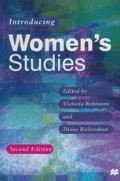Abstract
In recent years there has been a growth of interest in sexuality within and across many academic disciplines: for instance, in cultural studies and literary criticism (Butler, 1990, 1993; Sedgwick, 1990, 1993; Garber, 1993), geography (Bell and Valentine, 1995), architecture (Colmina, 1992), sociology (Giddens, 1992; Hawkes, 1996) and social policy (Cooper, 1994; Carabine, 1995, 1996b). A great deal of the impetus for this new interest has come from feminist research and theory on sexuality, as well as from lesbian and gay studies. It is not difficult to see why this should be so. Sexuality has long been a major issue within Women’s Studies, feminist theory and politics. Feminists, in examining specific issues such as prostitution, birth control, sexual violence, pornography, AIDS, heterosexuality and lesbianism, have asked the question ‘What is the relationship between sexuality and gender inequality?’ Indeed, it is this question which perhaps more than any other has provoked discussion and controversy within feminism.
Preview
Unable to display preview. Download preview PDF.
Further reading
Sheila Jeffreys, The Lesbian Heresy. A Feminist Perspective on the Lesbian Sexual Revolution (London, The Women’s Press, 1994). This book examines debates concerning sexuality within lesbian feminism, including the controversies surrounding the impact of sexology on the construction of lesbian identity, the politics of lesbian erotica, S/M, butch and femme roleplaying, drag and transsexualism. It also looks in a critical way at the impact of post-modernist ideas, in particular at the politics of transgression. As in her earlier work, Anticlimax: A Feminist Perspective on the Sexual Revolution (London, The Women’s Press, 1990), Jeffreys posits the view that the ‘sexual revolution’, far from bringing liberation and fulfilment, has actually upheld male power and reinforced women’s subordination.
Also useful is Margaret Jackson, The Real Facts of Life: Feminism and the Politics of Sexuality (London, Taylor & Francis, 1994).
A very different stance is taken by Lynne Segal in Straight Sex: Rethinking the Politics of Pleasure (London, Virago, 1994). This book explores the shifts and divisions in feminist thinking and practice around sexuality arid desire since the 1960s. In seeking to rethink sexual liberation as ‘progressive’ in terms of contemporary feminist politics, Segal explores a range of issues, including debates about heterosexuality, pornography, the influence of sexology, pychoanalysis and discourse theory on theorising sexuality, the contribution of lesbian and gay studies, as well as post-modern influences such as queer theory.
Carol Anne Douglas, Love and Politics: Radical Feminist and Lesbian Theories (San Francisco, ism Press, 1990). This book provides an overview of radical and lesbian feminist theoretical positions over 25 years, and looks at ideas on love and sexuality as well as divisions between feminists on these issues.
Stevi Jackson and Sue Scott (eds), Feminism and Sexuality. A Reader (Edinburgh University Press, 1996). This Reader brings together feminist writings on sexuality representing key issues and debates over the last 25 years. The readings are arranged around four main themes: Essentialism versus Social Construction; Affirming and Questioning Sexual Categories; Power and Pleasure; and Commercial Sex; they cover issues such as pornography, prostitution, sexual violence, heterosexuality and lesbianism, AIDS, Cybersex, queer theory, and the international sex industry. There is a useful introductory essay by the editors which summaries feminist debates on sexuality since the 1970s.
Diane Richardson (ed.), Theorising Heterosexuality (Buckingham, Open University Press, 1996). This book provides a critical examination of recent debates about heterosexuality, in particular within postmodern, feminist and queer theory. As well as examining the relationship between heterosexuality and feminism, heterosexuality is theorised in terms of its institutionalisation within society and culture, as sexual desire and practice, arid as identity.
Gail Hawkes, A Sociology of Sex and Sexuality (Buckingham, Open University Press, 1996). This book offers a historical sociological analysis of the development of ideas about sex and sexuality, from Classical Antiquity and early Christianity to the present. Although not written from an explicitly feminist perspective, it explores many relevant issues including the politics of reproduction, debates about heterosexuality and post-modern influences on thinking about sexuality, including queer theory.
Editor information
Editors and Affiliations
Copyright information
© 1997 Diane Richardson
About this chapter
Cite this chapter
Richardson, D. (1997). Sexuality and Feminism. In: Robinson, V., Richardson, D. (eds) Introducing Women’s Studies. Palgrave, London. https://doi.org/10.1007/978-1-349-25726-3_7
Download citation
DOI: https://doi.org/10.1007/978-1-349-25726-3_7
Publisher Name: Palgrave, London
Print ISBN: 978-0-333-68470-2
Online ISBN: 978-1-349-25726-3
eBook Packages: Palgrave Social & Cultural Studies CollectionSocial Sciences (R0)

